#protagonists name dai mifune
Explore tagged Tumblr posts
Text
FEATURE: Meet the Stars of Princess Connect Re:Dive
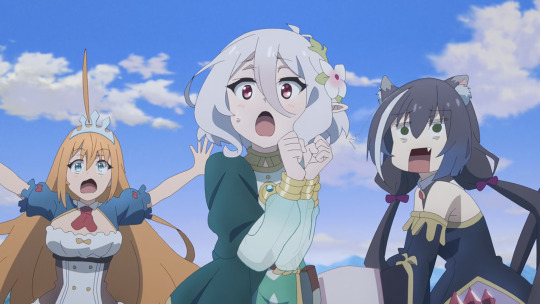
Going into Princess Connect! Re:Dive, I knew little about it other than the fact that it was an adaptation of a mobile game. That didn’t bode well; my experiences with video game adaptations have been less than positive.
Imagine my surprise, then, when it turned out to be hilarious. When a pair of ridiculous-looking wolves started dragging off our protagonist, I completely lost it. I found myself constantly laughing at the KONOSUBA-esque humor — it was only much later that I’d learn that Princess Connect and KONOSUBA shared the same director. It was also well-animated and delivered some impressive-looking action scenes and spell effects.
At the end of the day, however, this is a comedy anime through and through. And comedy anime live and die on the basis of their voice acting. Unsurprising, then, that Princess Connect features an all-star voice cast, with the actors from the mobile game reprising their roles in the anime. Let’s take a look at some of the talented voice actors that bring the characters of Princess Connect, both the game and the anime, to life.
Pecorine (M·A·O)

Mao Ichimichi, also known as M·A·O, is probably better known for her non-anime roles — she started off her career in tokusatsu (live-action often with heavy special effects), most notably playing Luka Millfy in Kaizoku Sentai Gokaiger. She later ventured into anime voice acting. She voices the cheerful and energetic (and perpetually hungry) Pecorine in Princess Connect. She has also voiced Iris in Fire Force, Luluco in Space Patrol Luluco, Hondomachi in ID:Invaded, Vorona in Durarara, Bela in Bem, and Remi Ayasaki in the currently-airing Horimiya.
Kokkoro (Miku Ito)

This isn’t the first time Miku Ito has played a character named Kokoro, having played the character of the same name in the BanG Dream! franchise. Her most well-known role is probably that of her own namesake: Miku from The Quintessential Quintuplets. Her other roles include Shimamura from Adachi and Shimamura, Ann Akagi from Action Heroine Cheer Fruits (in which she starred alongside fellow Princess Connect actor M·A·O), and Nana Mifune in Gleipnir.
Karyl (Rika Tachibana)

Rika Tachibana has an extensive voice acting career in video games, featuring in such titles as Granblue Fantasy, Magia Record, The Idolmaster Cinderella Girls, Street Fighter V, and of course Princess Connect, where she plays Karyl. Tachibana’s anime voice acting roles include Sae Kobayakawa from The Idolmaster Cinderella Girls, Reiko from Shomin Sample, Naruse from The Island of Giant Insects — in which she starred alongside ... you guessed it ... M·A·O — and African Wild Dog from Kemono Friends.
Yuuki (Atsushi Abe)
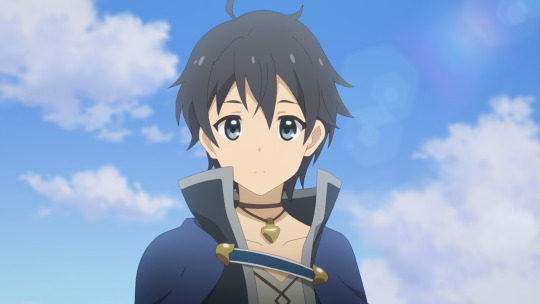
Our main protagonist Yuuki may not say much, but Atsushi Abe manages to make whatever little he says absolutely hilarious. Abe garnered widespread recognition for his role as Touma Kamijou in A Certain Magical Index and its spinoffs. His other roles include Moritaka Mashiro in Bakuman, Koichi Sakakibara in Another, Takashi in B Gata H Kei, Akiyuki in Xam’d: Lost Memories, Soya in Planet With, Inojin Yamanaka in Boruto, and Sougo in IDOLISH7.
Kaiser Insight (Shouta Aoi)
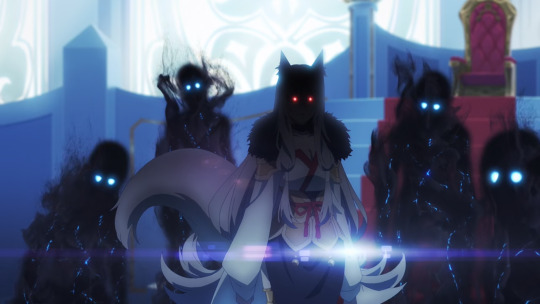
It is not uncommon for female voice actors to voice male roles, especially younger characters. But male voice actors voicing female roles? Extremely rare. Shouta Aoi’s unique, “angelic” voice allows him to do so, with him voicing main Princess Connect villain Kaiser Insight. Aoi is better known as a singer, but he made his voice acting breakthrough as Ai Mikaze in Uta no Prince-sama. Since then, he has voiced Hideaki Tojo in Ace of the Diamond, Licht in The Royal Tutor, and will voice Subaru in the upcoming adaptation of Tokyo Babylon.
Maho (Maaya Uchida)
Maho is considered by the other Princess Connect characters to be slightly delusional, so of course she is voiced by Maaya Uchida, best-known as the voice of out-of-touch characters like Rikka from Love, Chunibyo, and Other Delusions and Ranko Kanzaki from The Idolmaster Cinderella Girls. Her non-delusional roles include Yoshioka from Blue Spring Ride, Norman from The Promised Neverland, Yuki Yoshino from Food Wars, and Catarina Claes from My Next Life as a Villainess: All Routes Lead to Doom.
Miyako (Sora Amamiya)
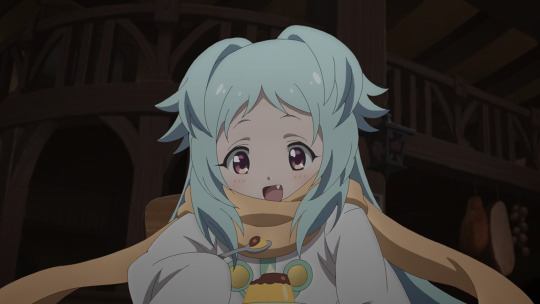
I mentioned earlier how Princess Connect feels incredibly KONOSUBA-esque, both in its setting and its sense of humor. Makes perfect sense, then, for it to feature the voice of Sora Amamiya, known for voicing “useless” goddess Aqua from KONOSUBA. Amamiya’s other notable roles include Elizabeth from The Seven Deadly Sins, Touka from Tokyo Ghoul, Akame from Akame ga Kill, Kaori from One Week Friends, Isla from Plastic Memories, and Asseylum from Aldnoah.Zero.
Hiyori (Nao Toyama)
Nao Toyama played her first major role as Kanon Nakagawa in The World God Only Knows, which kickstarted her music career. Many people also know her as Yui Yuigahama in My Teen Romantic Comedy SNAFU, or Chitoge Kirisaki in Nisekoi. However, the role for which I personally recognise her the most is as the quiet Rin Shima in Laid-Back Camp. Other major roles include Karen in KINMOZA!, Ruka in Rent-a-Girlfriend, and Nozomi in Sound! Euphonium.
Suzume (Aoi Yuki)
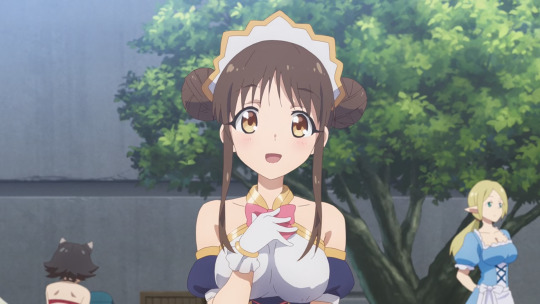
Aoi Yuki has been earning plaudits this season for her energetic portrayal of the titular spider in So I’m a Spider, So What? Yuki has had many significant voice roles over the years, including Madoka from Puella Magi Madoka Magica, Tanya in Saga of Tanya the Evil, Froppy in My Hero Academia, Tamaki in Fire Force, Diane in The Seven Deadly Sins, and Mami in Rent-a-Girlfriend.
Rei (Saori Hayami)
Saori Hayami is one of the most in-demand voice actors of recent times. She is known for portraying Yukino Yukinoshita in My Teen Romantic Comedy SNAFU, and received considerable praise for her performance as Shoko Nishimiya in A Silent Voice. Her other notable roles include Shirayuki in Snow White with the Red Hair, Shinobu in Demon Slayer, Tsuruko in AnoHana: The Flower We Saw That Day, Yumeko Jabami in Kakegurui, and Himawari in Boruto.
Jun (Ayako Kawasumi)
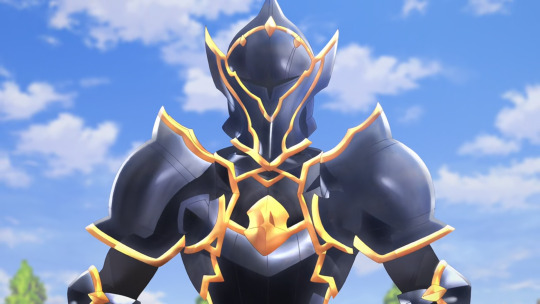
Jun is a classic knight in metal armor. And who better to voice a knight than Ayako Kawasumi, best known as the voice of Saber in various installments of the Fate franchise. Kawasumi is also a talented pianist, which explains her role as Nodame in Nodame Cantabile. Some of her other major roles include Fuu in Samurai Champloo, Erina Pendleton in JoJo’s Bizarre Adventure, Alice in Pandora Hearts, Melfina in Outlaw Star, Natsuki in Initial D, and Lafiel in Crest of the Stars.
Io (Shizuka Ito)
Shizuka Ito won a “Best Actress in Supporting Roles” award at the 10th Seiyuu Awards for her performances as Meiko Shiraki in Prison School and Sailor Venus in Sailor Moon Crystal. Some of her other major performances are as Himawari in xxxHolic, Ran in Texhnolyze, Kaori Kanzaki in A Certain Magical Index, Boota and Darry in Gurren Lagann, Yayoi in Psycho-Pass, Rei Hasekura in Maria Watches Over Us, and Hinagiku in Hayate the Combat Butler.
Yui (Risa Taneda)
Risa Taneda is undoubtedly best known for her roles as Erina Nakiri in Food Wars and Kaori Miyazono in Your Lie in April. But to me, she will always be Saki from Shin Sekai Yori, where she delivered an excellent performance spanning many ages, and performed the first ending song too. Taneda’s other significant roles include Rize in Is the Order a Rabbit?, Mirai in Beyond the Boundary, Yukina in Strike the Blood, Ai Mizuno in Zombie Land Saga, Xenovia in High School DxD, and Yukari in YUYUSHIKI.
Labyrista (Miyuki Sawashiro)

Miyuki Sawashiro is one of the most prolific voice actors of all time. She first came to prominence as the voice of Puchiko in Di Gi Charat; she famously reprised the role in the English dub of Leave it to Piyoko, becoming the first anime voice actor to voice the same character in both sub and dub. A few of Sawashiro’s other major roles include Kurapika in Hunter x Hunter, Celty Sturluson in Durarara, Bishamon in Noragami, Fujiko Mine in recent installments of Lupin the Third, and Kanbaru in the Monogatari series.
Aoi (Kana Hanazawa)
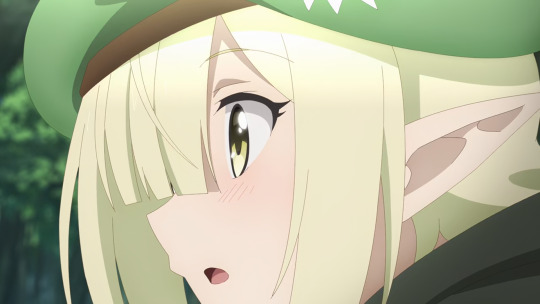
Kana Hanazawa needs no introduction, being one of the most popular voice actors of our times. She rose to popularity as Nadeko in Bakemonogatari and its sequels, performing the iconic opening song “Renai Circulation.” Some of her other anime roles include Akane from Psycho-Pass, Mayuri from Steins;Gate, Angel from Angel Beats, Kosaki Onodera from Nisekoi, Hinata Kawamoto from March Comes in Like a Lion, Kuroneko from Oreimo, and Ichika from The Quintessential Quintuplets.
Who is your favorite Princess Connect voice actor? Let us know in the comments!

By: Manas B. Sharma
38 notes
·
View notes
Text
The Phantom Thieves Came and Stole My Heart!
It’s been a while since I wrote a review here on Tumblr... I kinda lost interest in Tumblr for a good while, but I’m back because I want to talk about Persona 5. I have just finished my second run of the game and I feel like a review of this game would be too much to tweet about on Twitter so I thought it’s best to write here. Anyways lets start the review.
So I did a series of blogs reviewing all the Persona games from 1-4 in preparation for Persona 5. The game came out in September 2016 and we had to wait through a series of delays for the localized release of the game. Were the delays worth the wait for the game? I say yes because the game has exceeded all my expectations as I patiently waited for the game. The game was finally released April 4th 2017 world wide and everyone was excited, including me since I have been avoiding spoilers for half a year. I will discuss about those spoilers later in this review so this is your first warning here.
So Persona 5 starts off in a Casino where the protagonist and his friends are pulling a heist. Here you would be confused and ask the following questions: What’s going on? Why am I a thief? Why are the Police after me? Why did that guy turn into a monster? and What’s in the briefcase I’m carrying? All those questions will be answered later in the game. The opening scene ends with your character being caught by the police, interrogated after taking an overdose of truth serum and beaten up by the cops. A prosecutor named Sae Niijima enters the scene and asks you what happened from the very beginning. The whole story of the game from that point on is a flashback.
The flashback starts in April 20XX (yes no exact year but there are some theories when it takes place) with your character arriving in Shibuya searching for Sojiro Sakura who will be his caretaker for a year. Why is your character in Shibuya? You learn that your character was walking down the street in his hometown one night and finds a drunk guy yelling at a woman. Your character tries to play hero and stops the drunk but then he gets sued by the drunk. The result from that confrontation puts your character in probation from his hometown. So you start your new life living in the attic of a cafe that Sojiro works at. You get introduced to Shujin academy and start attending school there. On your first day of school you meet a blonde punk named Ryuji Sakamoto and they wind up at a castle instead of the school. This castle happens to be ruled by a king who has the appearance of the schools volleyball coach who you learn later is a major asshole. While trapped in the castle, your character awakens the power to summon personas summoning Arsene. They escape the castle with the help of a talking cat mascot named Morgana who also uses a persona named Zorro. After they escaped the castle they return to the streets of Shibuya confronted by police thinking they are 2 kids skipping school. They learn they missed half a day of school and your character wants to avoid as much trouble as possible since he is already on probation. Through the days in school you learn that the volleyball coach, Suguru Kamoshida, is an abusive coach who bruises his students with his spikes and sexually harasses the female students. His deeds have gone so far that a girl who he sexually harassed attempted suicide on school grounds. This all results in Ann Takamaki, a girl who happens to be your characters class, join you and Ryuji. Morgana finds our heroes in cat form and tells them that if they steal the treasure that lies in that castle, called a Palace, then Kamoshida will have a change of heart. Ann joins the group after awakening her persona Carmen, Ryuji also awakens his persona, Captain Kidd, before Ann. After the group succeeds in stealing the treasure, Kamoshida arrives school one day confessing all the crimes he did to everyone in a school assembly. The result of that success is the birth of the groups being known as the Phantom Thieves.
What I just wrote was all the first dungeon of the game. I’m not going in full detail about all the other chapters except for the end. I mainly wanted to write that just to show the buildup they made to show how much thought they put into creating corrupt characters in the game. The story goes on with the Phantom Thieves changing the heart of Ichiryusai Madarame, an artist who appears to be completely innocent at first, but actually plagiarizes the work of his pupils. The team recruit one of Madarames pupils, Yusuke Kitagawa after he learned about his masters corrupt nature in art. Yusuke awakens his persona Goemon and they changed the heart of Madarame. The next target was set by Shujins Student Council President, Makoto Niijima, since she’s been suspicious of the protagonist and his friends. Makoto wants them to change the heart of a mobster, after searching for information they learn about Junya Kaneshiro who runs a drug trafficking business with high school students involved. Makoto awakens her persona Johana and joins the Phantom Thieves in order to fight for what justice truly means to her. As the story goes on a student in the main characters class, Yuki Mishima, starts a fan site for the Phantom Thieves after they took down Kamoshida (There’s a legit fan site of this fan site online, it’s phansite.net) . After the Phantom Thieves changed the heart of a person, their fame increases. Due to their fame they received after changing Kaneshiro’s heart, a hacktivist group named MedJed threatens the Phantom Thieves to stop or else they’ll “cleanse” Tokyo. Instead of changing the heart of someone in that group of hacktivists, they change the heart of a girl who isolated herself from society for 2 whole years after her mother died. This girl was Futaba Sakura, adopted daughter under the care of Sojiro Sakura. After they changed her heart, she hacks into MedJed and saves the Phantom Thieves. She then joins the group after awaking her persona Necronomicon. Their next target was a request from... my favorite character in the game... my god I love her... Haru Okumura daughter to Kunizaku Okumura who is the CEO of Okumura foods who runs the equivalent to Burger King in the world of Persona, Big Bang Burger. Her father is a corrupt man who cares for personal gain, Haru requests the Phantom Thieves to change his heart since he put her into marrying an asshole who treats Haru like dirt than the softhearted person that she is. The wedding was mainly so her father can have a political connection in the company. Haru Awakens her persona, Milady and change her fathers heart... until you see his shadow get shot by a mysterious figure after the Phantom Thieves leave the scene. This results in Haru’s father confessing what he did, but then dying live on TV like a public execution. This results in the Phantom Thieves massive drop in fame and they get help from a detective who’s been onto the Phantom Thieves throughout the game, Goro Akechi. He tells them that they should change the heart of Makotos sister, Sae Niijima, the same Sae from the very beginning of the game, to help prove the Phantom Thieves innocent. Goro helps the team with his persona Robin Hood and they venture through what Sae sees a courthouse as a Casino. That’s right, we’re heading back to where the game started! The end results in what you saw from the very opening of the game bringing you back to the interrogation room with Sae.
That’s enough with the story, until I get to the heavy spoiler part. The game has wonderful presentation for it’s anime like story and characters. I love this group so much compared to other groups in the Persona series. Ryuji is an idiot who you’d like to butt heads with while he tries to do something right with his own actions. Ann isn’t bright but she’s caring and wants to learn how to be a strong. Yusuke is interested in finding many inspirations for his next art pieces wherever he goes, but is very bad with managing his money. Makoto is the most organized member of the group, but is tired of following the path others give her and wants to decide her life for herself. Futaba is characterized like a major gamer girl who is a mischievous hacker and is like the little sister character to the protagonist. Haru is an innocent rich girl who loves to garden and dreams of making her own coffee while trying to handle business with Okumura Foods after her father’s passing. Morgana wants to learn the truth behind his origins and teaches the main character how to be a Phantom Thief like a kickass sidekick. Goro is a dedicated detective who is willing to do anything it takes to solving a case.
The gameplay is fantastic, exploring Tokyo with the fast travel button is incredible and easy to use! Exploring town is similar to Persona 3 and 4 where you run around town talking to people and shopping at various stores. Social Links are now Confidants, but still work like Social Links. Confidants are incredibly useful in this game! Each Confidant gives you an ability to give the player a better gameplay experience in the game! Hanging out with your party members improves their combat performance. Outside your party members, the following characters have incredible improvements to gameplay. Yuki Mishima helps you get more experience in battle for both those fighting and on the sidelines. The main characters teacher, Sadayo Kawakami, does her job as a maid to do tasks that waste your characters time in the Cafe. Sojiro Sakura teaches you how to make coffee and curry which heals your party’s SP. The doctor who works at a clinic nearby the cafe, Tae Takemi, sells more healing items and accessories in the clinic. The ex-Yakuza who works at a model gun shop, Munehisa Iwai, helps you customize guns. The politician who wants to make up for his mistakes in the Diet Building, Toranosuke Yoshida, helps the character be better in negotiating with the enemy. A fortune teller who’s part of a cult, Chihaya Mifune, gives fortune telling sessions that tells you what abilities your party members will get in the future. A reporter who likes to drink, Ichiko Ohya, helps write articles about the Phantom Thieves and decreases the threat levels when the player is spotted by the enemy. A kid who’s raised to win everything in life, Shinya Oda, helps improves the main characters skills using a gun from playing a gun video game. A professional Shogi player, Hifumi Togo, gives the main character new strategies to use in battle. The last confidant outside of the party members are the twin Velvet Room attendants Caroline and Justine. Just like Margaret from Persona 4, they want you to create personas with certain skills. After completing each task, they’ll give you a new service to use in the Velvet Room.
Dungeon crawling in the game is incredible! It’s like I’m playing an Anime version of Sly Cooper without the insane stunts Sly does. You sneak around the dungeon and do sneak attacks on the enemy to engage in battle. If you get spotted then the person who owns the dungeon will become aware of you. If you fill the meter to 100%, you’ll be kicked out of the dungeon. Now to talk about what is the best combat system in any game I have played in my life! The combat is simplified by simple button presses, not going through menus selecting a physical attack or a spell. The only menu you go through is for using items, and the spells a persona has. When you knock down all the enemies with either a critical hit or their weakness, you’ll put them into an interrogation stage. This phase is reminiscent to classic Shin Megami Tensei and Persona 1 and 2 games. You make a deal with the enemy on letting them give you an item, money or become the main characters next persona to use. If it fails the enemy can comeback and attack. Or if you want the battle to be done with, just press the all-out attack button to let everyone in the party attack the fallen enemy. Another nod to Persona 1 in this game is that the characters use guns again! Now they wield physical weapons and guns. Bullets are limited though and you don’t find ammo in dungeons. They reload when you leave the dungeon and return another day.
The music is phenomenal! I never felt like dancing to a song in a game so bad when I play it! Shoji Meguro has done an incredible job implementing jazzy songs into a game about a band of thieves. The battle theme is incredible, I love the guitar riff in the boss theme, the song that plays at night when you return to the cafe is so relaxing. There are so many great songs in the game that I’m pleased to have a CD of the soundtrack from preordering the Take Your Heart Collectors Edition! Seriously, look up the following songs that I love so much: “Last Surprise”, “Life Will Change”, “Blooming Villain”, “Beneath the Mask”, and “Whims of Fate.”
Ok from here on I’ll be discussing spoilers of the last 2 dungeons of the game, you have been warned.
So after the flashback ends, you learn that the traitor of the group was Goro. He planned the Phantom Thieves pull a heist on a certain date and bring cops to that Casino. It turns out he works for a corrupt politician named Masayoshi Shido who happens to be the same guy who sued the main character in his hometown. Shido has been using Goro’s powers to kill people in the Metaverse, the world where people’s Palaces are held, in order to improve his image while he runs for Prime Minister of Japan. Goro was also hired to kill the protagonist after capturing him in the Casino. The Phantom Thieves manage to pull a stunt that makes the main character fake his own death. Futaba hacked into Goro’s phone and triggered him into the Metaverse killing a fake protagonist while the real one sits quietly in the real world with a smirk on his face. After the protagonist returns to the cafe, they all target to change Shidos heart. Shido has been behind many events in the game. Not only did Goro kill people for the election, he also killed Futaba’s mother and hired government officials to read a fabricated suicide note telling Futaba how much her mom hated her and was always in the way of her research of cognitive psience. Shido ordered her killed so he can take her research and use it to his advantage for his campaign. Shido also planned on using the Phantom Thieves fame against themselves by letting Goro kill Haru’s father after they took his Palace’s treasure. While the team explores Shido’s dungeon, they encounter Goro and fight him. Turns out Goro uses another persona, Loki, who brings people into chaos. After the battle, Goro is killed by Shido’s vision of Goro who is a mindless puppet used for killing people. Goro’s backstory turns out that he was abandoned by his parents and Shido was his father, Shido used his son as his own personal assassin for his own political gain. After the thieves change his heart, Shido confesses all of his crimes during his victory in the election. However, his team wishes to defend him by running the government the way he envisions it. After the Phantom Thieves made their comeback, since the news reported about the leader committing suicide through Goro’s attempt on killing the protagonist, the reception from society on the fan site isn’t as big as they expect and Shido isn’t being put on trail from his crimes. The final solution to this issue is to steal the heart of the pubic, which is located at the base of a Palace that’s created by the public as a whole, Mementos. Mementos is like Tartarus from Persona 3 meets the Abandoned Factory/Bomb Shelter from Persona 2. You explore the area and fight enemies from previous dungeons while going deeper and deeper into the abandoned subway tunnels. At the very base of Mementos is a structure known as a Holy Grail that gains power from people in society who believes it is their true meaning of life. I love what they did here with Mementos where it’s the game straight up saying we are prisoners of society. The characters you changed the hearts of through the game are like the ex-cons of society. You learn that the figure behind that Holy Grail is a god who wishes to send the world to ruin by letting humans not think about their paths in life. The biggest twist out of it all was that Igor, the master of the Velvet Room, was that corrupt god the whole time and the attendants, Caroline and Justine, are 2 halves of one attendant named Lavenza. Morgana learns that he’s a Velvet Room attendant as well but was created from the last pieces of hope from humanity before that god took over. The last dungeon is the Phantom Thieves fighting Angels and other demons as they climb their way through a world where reality and Mementos has merged. At the very end they fight that Holy Grail one last time revealing it’s true form, a god of control known as Yaldabaoth. They go through one intense fight against the god where he uses abilities from other bosses against the party and they impress the corrupt god with their power. At the end society learns that the Phantom Thieves are alive and fighting a god and their support for them increases the fan site meter to 100% letting the main character summon the biggest, baddest of all ultimate personas in the series! A being known as a demon lord who defies god to make a fitting end for the Phantom Thieves adventure, Satanael! Sataneal uses his skill, Sinful Shell, on the corrupt god and lands a headshot on him ending his reign on society.
Our heroes have saved society from god and are ready to have a Christmas party for the celebration... however... feels attacks... Sae tells the protagonist that they need his help in order to prove Shido guilty from what he has done since the Phantom Thieves are the only one who can prove what the Metaverse is. In order to do that, the main character has to turn himself in which will result him to Juvenile in Solitary Confinement. After receiving the news... to make the scene worse, the girl who you put your character in a relationship texts you for a Christmas Eve date. You spend time with her one last time before going to Juvie. The next day, everyone in the Phantom Thieves is crying and freaking out about how they saved the world and their leader is treated like a criminal in the end. Time flies while the main character is in prison and you see all the Confidants you max out with try to help prove your innocence. At the end, you get released early after Shido confesses that he sued your character for assault that he didn’t do. The protagonist returns home to his friends and they all celebrate the wonderful reunion. The next day is Valentines so you spend with whoever you dated. Then at the very end, once you let the main character say his goodbyes to everyone he met, he takes a trip with the Phantom Thieves on a van to solve issues that are requested on the fan sites forum posts in reality.
This ending, has made me cry more than the ending of Persona 2 Innocent Sin. I cried in a roundabout way from sadness to happiness... I don’t think I’ll ever experience that feeling again after that game. I have enjoyed everything the game brought to use Persona fans, along with cameos to other characters in the Persona series you see on TV like in Persona 3. The DLC costumes are a lot of fun to use since they change the battle theme if you get sick and tired of “Last Surprise,” or just want to goof around with some costumes. The Confidants are really useful if you do a Max Confidant run cause they make you feel insanely powerful at times! After playing this game, it pains me to say this, but it’s true... Persona 5 just took over Persona 2 Innocent Sin as my number 1 favorite Persona game in the series. The ending was entirely better than Innocent Sin’s ending since it was mostly on a sad note while Persona 5 was sadness to happiness. I highly recommend you get this game, even if you are or are not a Persona fan, it’s a wonderful JRPG experience. This game has stolen my heart, and I like it.
That was a lot to write about, I wanted to share how much I enjoyed Persona 5 to everyone as best I can. Now that the review is pretty much done, I bid you all...
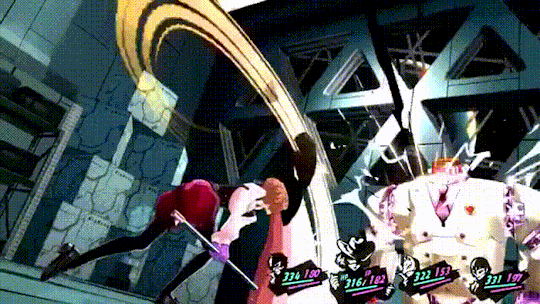
GOD I LOVE HARU!
#Persona 5#Phantom Thieves#ryuji sakamoto#ann takamaki#haru okumura#makoto niijima#morgana#yusuke kitagawa#Futaba Sakura#goro akechi#Atlus#PS4#PS3
65 notes
·
View notes
Text
Rashomon: An appreciation of the language of Japanese Cinema
Warning: Spoilers!

A long time ago, during those first flourishes of cinephilia that would consume my life, I made it my duty to watch as much as I could. I wanted to experience movies from all parts of the world, all corners of the earth as it were.
The first flourishes of this obsession with the movies were fed and watered by America, specifically Hollywood, but soon films from elsewhere would make themselves known to me and my pallet expanded. I discovered the various new waves that seemed to pop up occasionally and all those new and exotic names that now seem as familiar to me as, well, as family. Names like Rossilini, Truffaut, Godard, De Sica or Almodóvar. These were names that have continued to pop up over and over again as my appreciation continued to grow.
But there were two names which seemed, to my small-minded, limited experienced imagination, more strange and peculiar than all the others – Yasujiro Ozu and Akira Kurosawa. Maybe it was because many of the other behemoths of cinema came from the relative proximity of France, Italy and Spain; European cousins who were both unusual in language yet possessed a sameness which was easy to identify with, whereas Japan was thousands of miles away with a very singular culture and history. Or, and this is I think more likely, it was because they just made brilliant movies.
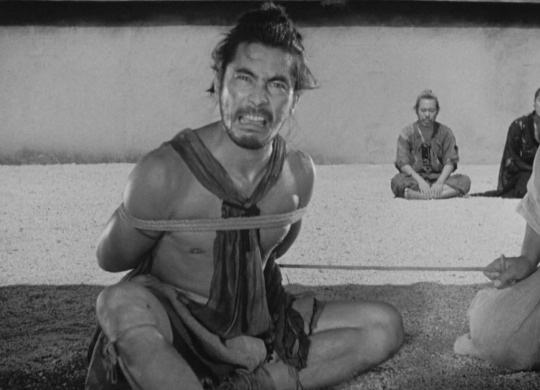
I have written of my love for the small number of Ozu movies I have so far managed to track down here, a love that was first kindled with the sublime Tokyo Story. Both he and Kurosawa examine the minutiae of Japanese culture that was both peculiar and universal. I think that this was because the themes, whilst specific in their use of Japanese cultural norms, were also understandable to the outside world as well. We might not understand the significance of the tatami shot used so frequently by Ozu in Tokyo Story (and all his other films) but we do understand the emotions that the film explorer – disappointment, grief, loss, etc.
The same can be said of Kurosawa. A samurai may look particularly strange to western eyes, the histrionics of the great Toshiro Mifune may bring a smile to your face when you first see them, but you can't help but be moved by the plight of the villagers in The Seven Samurai (reviewed here)or the hopelessness of those trapped between the two warring factions in Yojimbo.
One of those films I saw during this blossoming of my filmic adulthood was Kurosawa's (and Japan's) first real international success – Rashomon. It has been a long time but thankfully, today, I revisited this 1950 masterpiece.
If there is one film that proves the point that I have been trying to make, it is this. Rashomon is the story of a murder, or more specifically, the stories of a murder as the details of what happened change ever so slightly with each telling.

The story is told by a Woodcutter (the wonderful Takashi Shimura), a Priest, a Wife, a Bandit and even the victim himself, who speaks through a medium. The facts are these, a man and his wife are travelling through a forest and are spotted by Tajomaru, a bandit well known in the area. At the end of the encounter the man is dead. Beyond that the truth becomes diluted behind a veil of lies and deceit.
Afterwards the Woodcutter and the Priest take shelter from a storm beneath the ruins of the Rashomon Gate and are encouraged to tell their stories to a passerby who shelters with them.
First they tell their own stories – the Woodcutter found the bodies and the Priest was the last person to see them alive – then they recount the versions as told by the other characters involved. Tajomaru claims he was the killer, the wife suggests that it may have been her and the ghost of the dead man claims he took his own life. These are not people lying to save their own lives as they all claim to be the murderer themselves, they are lying to hide a bigger, more fundamental and important truth. This is what drives the film and is slowly revealed through the astute questioning of the passerby.
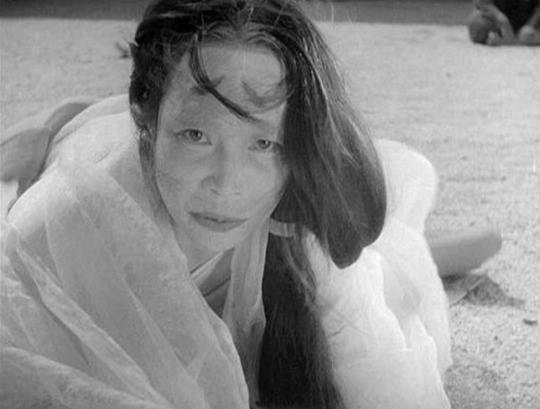
I am not sure if I have the vocabulary to explain each person's individual's motives and do them justice but I will try. The priest is troubled by the possibility that man may harbour a deep rooted sin which he finds difficult to understand; The Woodcutter wants to stay out of trouble (the only way, for a westerner, to possibly fully appreciate the situation he finds himself and the dilemma he faces in is to watch other Kurosawa's films, especially Seven Samurai which explores the desperation poor villagers live with. Of course, for a Japanese audience this would not be an issue.)
The bandit's lust is perhaps the most understandable although his later decisions regarding the woman are far more subtle as is the husband's rejection of her. Finally, as we don't have any back story for the man or woman, it is difficult to understand her flipping between the man she is married to and an uncouth stranger they meet on the journey.
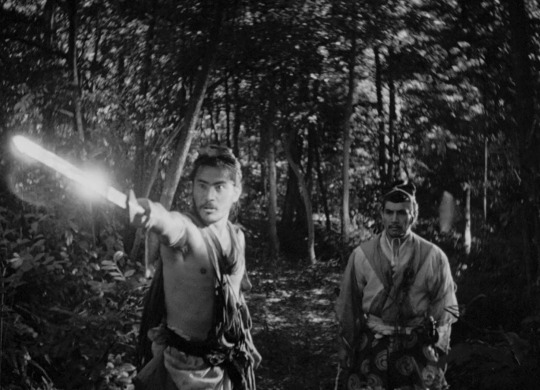
But this where the understanding of Japanese culture derived from watching and rewatching the films of these wonderful filmmakers bears fruit and the real theme of the film becomes clear – Honour.
Each retelling by one of the three principals involved in the murder acts as a way of preserving the honour of the teller: the wife doesn't want anyone to know of her shame at rejecting her husband in favour of the bandit, the husband doesn't want to live with the fact that his wife would reject him like that and so seppuku (suicide) is the more honourable outcome. As for the bandit, he knows that he will be paying the ultimate price for the death and doesn't want anyone to believe he could be manipulated like he was.
Of course, the truth does come out, the woodcutter saw everything but did not want to tell and because of this the priest rejects him. To the priest the woodcutter briefly represents all the lies and deceit that he has been witness to that day, but as they hear the cries of an abandoned baby, the Woodcutters unselfish attitude wins him over, restoring a little faith in humanity one more time.
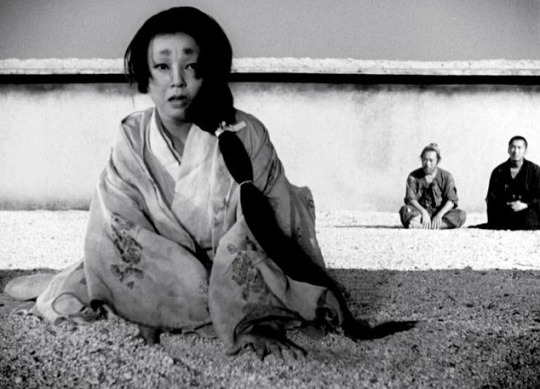
Watching the films of Kurosawa one can't help by notice the over exaggerated performances: words are spat out, the characters continuously throw themselves to the ground, the fights last a long time until the characters are completely out of breath and reduced to wild lunges with their swords, the medium trashes about, speaking with the dead man's voice, when slighted characters seem to run a great distance away from the others to mope in solitude. But a Kurosawa Samurai film is not about reality, they are not depictions of real life, they have much grander themes than this.
It is also important to note that the judge to whom the parties tell their stories is off camera and silent. The protagonists speak directly to the camera so it is as if we, the viewer, is the judge. The fourth wall is almost compromised making us complicit with the actions onscreen.
In many respects Kurosawa and Ozu represent two sides of the Japanese coin – Kurosawa's grand gestures compared to Ozu's focus on the tiniest details, but at the same time they speak to us the same way. They may seem alien to a western audience and their language may sound strange to our ears but their words are easily translatable into our own understandings and experiences. We know what they are saying even if we have to learn the language they are speaking. The best way to learn this language (by which I mean filmic language rather that dialect) is to watch the films of these greatest of filmmakers, to sit at the feet of these masters and consume every nuance like a dutiful student.
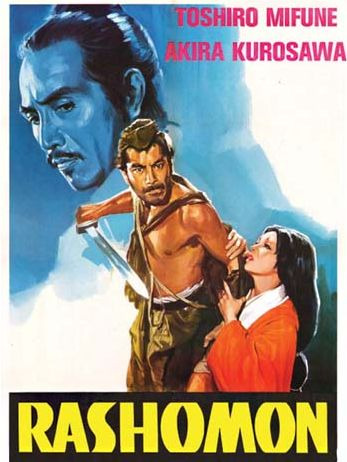
Whether it is in the movement of Kurosawa or the stillness of Ozu, this language is visual. Ozu began his career in silent films and Kurosawa proclaimed his appreciation for Silents on many occasions. So I implore cinephiles and would-be cinephiles wherever you are in the world to watch these films, to learn their language and I guarantee you will get a better understanding of the world, of cinema and of yourself.
youtube
1 note
·
View note
Link
by The_Gay_Silverware
Akira was just having a regular day, until it fucking wasn't. Somehow Akira was transported into another universe, there everything is the same except for one small thing. There's another him, but his name was Ren Amamiya and he's dating Ryuji Sakamoto. Akira was dating the one and only Iwai Munehisa. Akira and everyone in the alternate universe had a "lovely" conversation.
Words: 1085, Chapters: 1/?, Language: English
Fandoms: Persona 5
Rating: Not Rated
Warnings: Creator Chose Not To Use Archive Warnings, No Archive Warnings Apply
Categories: M/M
Characters: Iwai Munehisa, Persona 5 Protagonist, Amamiya Ren (Persona Series), Kurusu Akira, Kitagawa Yusuke, Takamaki Ann, Niijima Makoto, Morgana, Sakura Futaba, Okumura Haru, Sakura Sojiro, Mifune Chihaya
Relationships: Iwai Munehisa/Kurusu Akira, Amamiya Ren/Sakamoto Ryuji
Additional Tags: Daddy Kink, Slut Shaming, Alternate Universe, Biting, Akira ends up in a alternate universe
0 notes
Text
CanvasWatches: Seven Samurai
About time I start looking into the highbrow stuff much lauded by film historians and critics and the like. Become cultured and so forth.
Though the subject is a Japanese Film, so I’m still clinging to some of my innate nature.
I didn’t watch it dubbed though! Not that the Criterion Collection BluRay had the option. To be fair, I don’t watch live action material with English Dubs. I have my lines.
This probably won’t be the last time I venture into this general area. Akira Kurosawa[1] has a few other notable films I’m intrigued by (Rashomon and Throne of Blood are particularly tempting)[2]. As with all things, no promise of when or if I’ll get around to them.
Anyways, Seven Samurai. Let’s get into it.
Seven may have been too many samurai. Sure, I could (visually) keep track of Kambei and Katsushiro as the Veteran and Newcomer archetypes, and Kyuzo and Kikuchiyo[3] as the clear inspiration for Jin and Mugen of Samurai Champloo, but I was unable to track their names, not helped by the language barrier of the actual dialogue.[4]
Not that I feel it matters, since the movie’s not a character-driven piece by any means.
We open with a farm village soon to be attacked by bandits, which isn’t good. After some discussion, the farmers decide the best course of action is to recruit some samurai. So four farmers travel off to do just that, feeling their chances are slim due to having only food to offer.
Kambei is moved by their plight, and agrees to assist the farmers, becoming the commander of the operation and taking over the recruitment of additional samurai.
Kambei decides on forming a team of seven.
The section where the team is being assembled is my favorite part of the film, probably since it’s where most of the cast get the entirety of their development. Kambei recruits an old war buddy and some other random samurai, who then recruits a man who is obviously meant to be the comedic relief (Heihachi doesn’t get enough dialogue to make good on this). Kambei offers a spot on the team to Kyuzo, a man who wishes to test his skills, and Kikuchiyo (the proto-Mugen) stumbles in drunk and walks along with the group until they agree to let him in.
Then they walk to the village, then start planning for combat, then engage in combat, then come to a costly victory, and the end card goes up.
It’s combat heavy, and not particularly good combat either.
To summarize the deaths: ‘Tag, now play dead.’ The hits don’t even look like an attempt was made to look realistic. It’s both a little funny and very disappointing.
I mean, the fighting takes up most of the second half, you’d think a little more effort and choreography could’ve been put in.
Because of the focus on the combat, the movie can drag on a bit, especially since there’s relatively little character development, and it can be hard to track deaths and the samurai since the language barrier and lack of color strips away much of the distinguishing features. You can mostly distinguish the farmers from samurai since the farmers all have bald caps of vary quality, a trait shared only by the two least distinctive samurai.
Kambei makes a good leader figure, looking the oldest and carrying the most wisdom. He’s introduced using guile to save a young boy from a thief, which foreshadows the tactical forethought he puts into defending the village, though he uses relatively conventional methods in that case. He survives the film with a wistful comment about how, ultimately, the villagers won since the bandits are gone, more than half the samurai fell in the conflict, and all the survivors got out of it was food. Intentionally or not, the farmers got the samurai to work for no personal gain.
Were this a more modern film, Kambei would’ve been under one of the burial mounds after successfully mentoring Katsushiro to be some noble warrior guy.
Katsushiro[5] plays our Zeppo Marx: the young innocent looking to find his place in the world and woos the only young female (Shino). He apprentices himself to Kambei because he has to learn the trade from someone. He and Kikuchiyo provide most of the actual comedy in the film, despite previous attempts to pretend Heihachi would be the funny one. He’s mocked for his youth, used as a tool for slapstick when recruiting samurai, and is only added as one of the titualar samurai because they ran out of time and needed to bolster their ranks.
Katsushiro’s romance with Shino has some ambiguity: either it was an actual case of young love, or Shino was chasing a youthful indulgence before settling into a life of toil. Either way, it clearly ended when Shino’s father got upset when became… er… “damaged goods” by the film’s words. But hey, the kid lives, and that’s not nothing.
Which brings us to Kikuchiyo, who (in a modern film) would’ve fought with Katsushiro to be the de facto protagonist. I just called him Mugen when commenting on the film since I couldn’t remember names, and the creative genealogy between the two is very clear. Kikuchiyo is a low born with an overly fancy sword fighting tooth and nail to prove he’s the toughest. Heck, a rivalry with the film’s proto-Jin even causes some trouble!
He’s also a consistent scene stealer, and has the best defined personality, being brash and blunt, finding success not through talent or training but by sheer force of will. The other six didn’t even want him as part of the team, but he persisted in following behind and then succeeded in getting the village to actually meet with the samurai.
Kikuchiyo engages in slapstick, jokes about and teases his squad of militia farmers, and generally is the most consistently funny cast member, but when it comes time for him to be dramatic, Toshiro Mifune commands the scene that drives home the true tragedy of the farmers: these are men regularly preyed on by bandits forced to rely on samurai, who have casually destroyed their lives and homes in the name of their wars. Yes, the farmers have killed and stolen from Samurai in the past, but they had to.
Kikuchiyo wears his emotions on his sleeves, can’t stand still, and constantly has to be doing something, even if it’s hypocritically yelling at others for crying. He may be Proto-Mugen, but he also shows traits common with many Shonen Protagonists and lancers.
He is the quinticessal Red Oni, but has no Blue Oni to balance him.
A tragic take on the Monkey King.
You start the film for the prestige, but you stay for Kikuchiyo, a man who dies wearing a stolen name.
It’s a war movie that, while bloodless, still doesn’t hide the horror of war, even those of a romanticized age.
So, as it happens, I can actually recommend this high brow film, though I can’t promise it would be easy to love. It’s long, dry in parts, and could stand a few less quiet moments. But there’s a lot of recognizable beats and tropes and characters that continue to echo to this day, and the good scenes are really good.
So try and watch it. At least get to the part where they reach the village. If you get thrown out by how remarkably dull the battles are, I won’t blame you, but it’s worth the attempt.
Thanks for reading. I welcome any comments or questions you may have. I’ve written other reviews and sometimes even original content, and I have a patreon which I’d like to use towards making my own masterpieces. I look forward to what inspirations I can take from Seven Samurai.
Kataal kataal.
[1]Kurosawa Akira? Still don’t know how I should format these names. [2] Hidden Fortress might be a good companion to the Star Wars rewatch I keep meaning to do. [3] Ya know, the K names! [4] Really need to put effort into actually learning Japanese… [5] A name I presume means ‘fried castle’.
0 notes